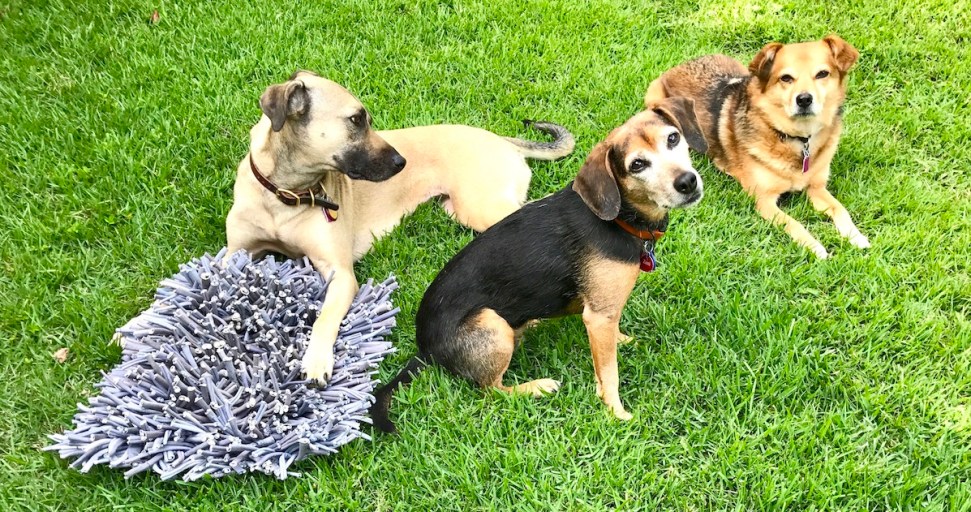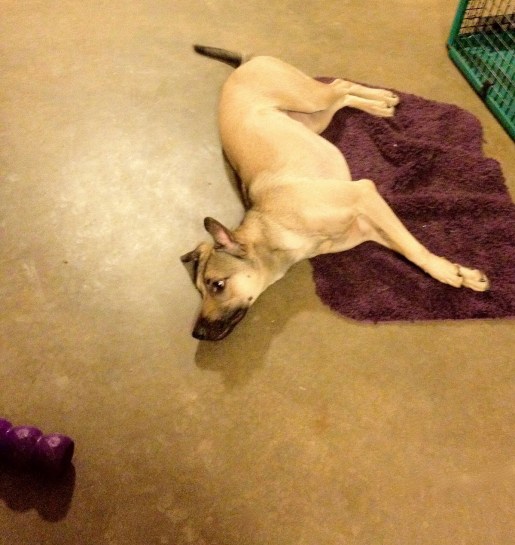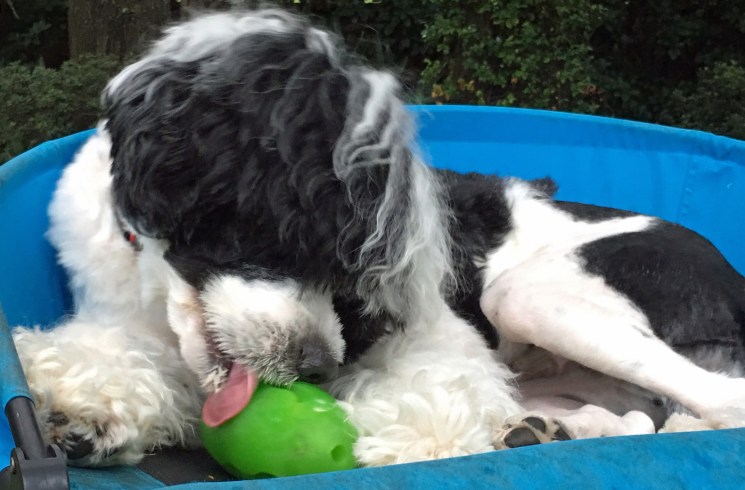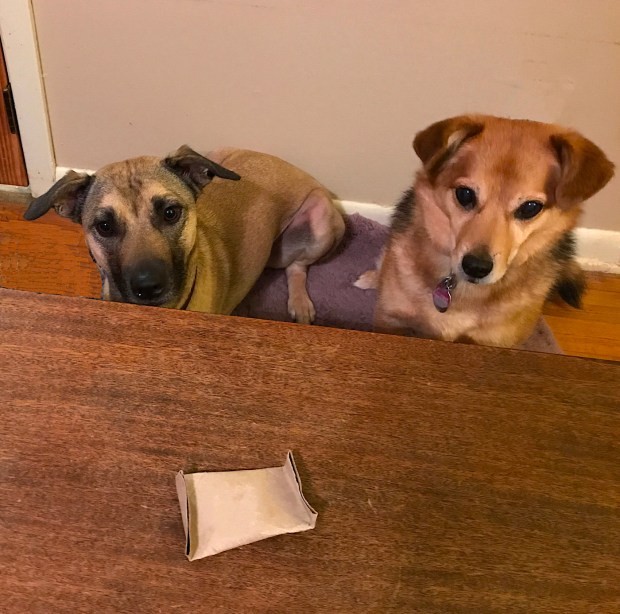Barks Blog
Are You SURE Your Dog Prefers That Food Toy?
It just occurred to me that it is super easy to make assumptions about how much our dogs prefer a particular food toy, or even whether they really enjoy them that much.
Don’t yell at me. To be clear: I use food toys for my dogs every single day. I think they can be enriching and that they are ethical things to use.
But food toys present us with a funny little problem. The laws of behavior get in the way of something we might like to know. How can we tell which toys our dogs like best? Or whether they like them at all?
Classical Associations
Most of this post is about operant behavior, but here’s a quick run across the classical domain. Any event or object that predicts food can prompt an animal’s responses to food if the pairing is consistent. My dogs salivate when I open the silverware drawer at a certain time in our morning routine. It’s because I then grab a spoon before administering pills embedded in peanut butter. The dogs weren’t born with that response. The silverware drawer meant nothing until it came to predict peanut butter. Here’s another example: one of my dogs salivates when another dog barks. (Really!) And we frequently see the signs of the positive conditioned emotional responses that go along with the body’s preparation for of food. For instance, most hungry dogs will perform excited behaviors in anticipation of their food bowl or toy.
Filled food toys predict food perfectly. If a dog is healthy, has a normal appetite, and can get food out of a particular toy, she’ll likely be delighted to see it. But that excitement is not a pure love for the toy itself. We can’t easily separate the toy from the food the dog gets out of it.
Preference Tests and the Matching Law
So if it’s hard to tell what part of a dog’s excitement about a food toy is about the food itself, then it’s also hard to tell which toy a dog might prefer over another.
Can we use a preference test to determine a favorite food toy? I’ve written recently about them and how easily we can mess things up when we try to determine our dogs’ preferences. There are several types of tests, and some are more appropriate for testing dogs’ preferences than just putting an item in each hand and waiting to see what happens.
The most basic preference test is a “free operant observation” test. In this type of test, the animal or person has access to several potential reinforcers over a period of time. An observer tracks the amount of time the participant interacts with each item. This method removes a lot of the problems that can give us false results.
But food toys have food in them. If a hungry dog is put in a room with three different food toys he is familiar with and that contain the same kind of food, he will make choices roughly according to the matching law. He will most likely gravitate toward the toy he can get the food out of the fastest first. As that one empties and the rate gets slower, he will likely switch to another toy. (Most toys yield food faster when they are full.) It’s unlikely that a dog will be making any kind of choice other than “what will get me the most calories the fastest right now” if the toys are equally familiar.
This would also apply if one toy held much higher value food than another. Usually more preferred food has more calories. (Not always, but usually.) So the matching law would still be in effect if the dog took five minutes to ingest a couple of tablespoons of peanut butter before taking one minute to eat a similar mass of low-calorie kibble that had less than one fifth of the calories.
Un-Fun Toys
Two toys came out a couple of years ago that were marketed heavily. They looked great. Both were stationary and were challenging because of their shapes. They didn’t require much creativity or skill, just persistence. (I’m purposely not naming them here. I don’t think there’s anything wrong with them and I don’t want to single them out as “bad” in some way.)
My teacher bought one of them, and after a while said that she thought it wasn’t fun for the dogs. All it did was slow down their eating. I bought it from her to see if my dogs liked it. I came to the same conclusion after a while. I donated it to a breed-specific rescue for a breed prone to bloat. The manager said they got plenty of dogs who just needed to slow their eating down a bit, and this was perfect.
But honestly, my dogs never acted disappointed or thwarted by these toys. They wagged their tails and did the suppertime happy dance just like they did with every other food toy I gave them. It was just my educated guess that the toys weren’t as fun because there was no movement. There was no particular behavior required beyond doing a lot of persistent licking to get the kibble out. That made the meal last longer, but there was no challenge, no skills, no problem solving involved.
I guessed that my dogs would prefer toys that involve movement, since they prefer that in general. But it was only a guess.
Ethics sidebar: If my dogs’ normal habit is to eat as fast as possible, is it ethical to use food toys to slow them down? My glib answer is that anything that relieves boredom, that is stimulating, that brings some interest to their lives in our house and yard, is a good thing. That’s the major idea behind food toys. I’m looking at the whole picture when I make the decision to use one. But would the dogs agree? Hmmm.
Contrafreeloading
This is the place where someone will bring up contrafreeloading. Contrafreeloading is an observed phenomenon where an animal will choose to work for food rather than eat food that is available without work. Does this prove that food toys are good in themselves? Not necessarily. There is some evidence of contrafreeloading in several species, but it’s not as common a phenomenon as many think. There are both learning theory and ethological hypotheses for the function of the behavior. You can check out the abstracts of the review articles below if you want to know more. The important thing to keep in mind is that it appears to happen a lot less often than eating the easily accessible food. In other words, animals that do contrafreeload don’t always do it or even mostly do it. So I don’t think it’s fair to use contrafreeloading to support a claim that food toys are always and automatically better for our dogs.
(You can do a test. Split your dog’s meal between an open bowl and a food toy and put them next to each other in your dog’s eating area. Release the dog. What does she eat first? Try it both when she is extra hungry and when she is rather full. Is her behavior different?)
Two Winners and a Runner-Up
When wondering about how to tell whether my dogs prefer a certain food toy, two examples come to mind. One is that over the course of my life with my dogs, I have taught them to search for food. I started small, using boxes as in a canine nosework class. I built the searching behavior and the dogs got so skilled that I could hide food anywhere in my house and each one could find it (even if I had the same food. Then we expanded the search to the back yard and developed their skills outdoors. Nowadays I have to make very difficult hides—elevated or placed under something—unless I want them to run straight to it. They are all skilled. What they search for is a folded up piece of a cardboard paper towel roll with about 7-10 pieces of kibble in it.
Their body language—all three of them—is that of thrill and delight. They love sniffing out their food. They can’t wait for their turns. But the reward is relatively low value. Their excitement seems out of proportion to the food alone. Sometimes one of my dogs will leave a piece of kibble or two in a regular food toy. “Meh, not worth it.” Never in the yard. They will search every piece, then cruise the yard again after the other dogs’ turns just to make sure. I can safely say that there is fun in this activity above and beyond actual eating.
And like most R+ trainers, I can say the same about training. My dogs love the combination of interacting with me, learning things, and getting food. Again, their demeanors tell me that there is fun in this activity beyond the food. Although they get excited for meals, they get thrilled at training sessions.
And here’s the runner-up. I have a tentative candidate for another favored food toy. It’s one that is comparatively easy, but involves that searching behavior that seems to be so fun. It’s the Snuffle Mat. Here’s a link to the Snuffle Mat I purchased, from Your Mannerly Mutt, a store owned by a positive reinforcement based trainer. You can also make your own.
I rotate our one Snuffle Mat among my three dogs as an alternative food toy. And I’ve noticed that when I prepare to put it down for another dog, Summer will leave her own area where she usually waits for her food to come and watch the mat. She may jostle the other dog (atypical for her) to get closer. It’s clearly attractive. She normally ignores the other dogs’ food toys. This appears to be a favorite. But playing devil’s advocate to my own argument (a.k.a. falsifying), I could propose that it’s because it’s a big visual target. Or that it appears more “open” with the food more accessible like a big bowl. Either of those could be the reason. But it also could be true that the foraging behavior required makes it a more fun toy.
I think I need to buy at least one more. I’m sure my dogs think that more tests are in order.
Anybody else have observations about whether your dogs might prefer one food toy over another? Can you rule out matching law factors? Do you have a way to quantify or at least describe the behavioral difference?
Resources on Contra-Freeloading
Inglis, I. R., Forkman, B., & Lazarus, J. (1997). Free food or earned food? A review and fuzzy model of contrafreeloading. Animal Behaviour, 53(6), 1171-1191.
Osborne, S. R. (1977). The free food (contrafreeloading) phenomenon: A review and analysis. Learning & Behavior, 5(3), 221-235.
Photo of Portuguese Water Dog Zip copyright 2017 Marge Rogers.
Text and all other photos copyright 2017 Eileen Anderson.






